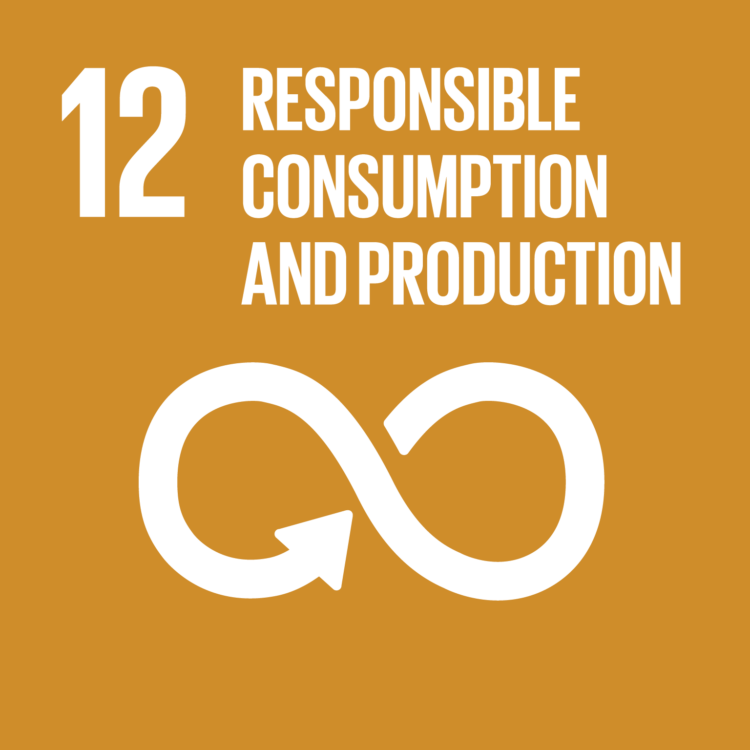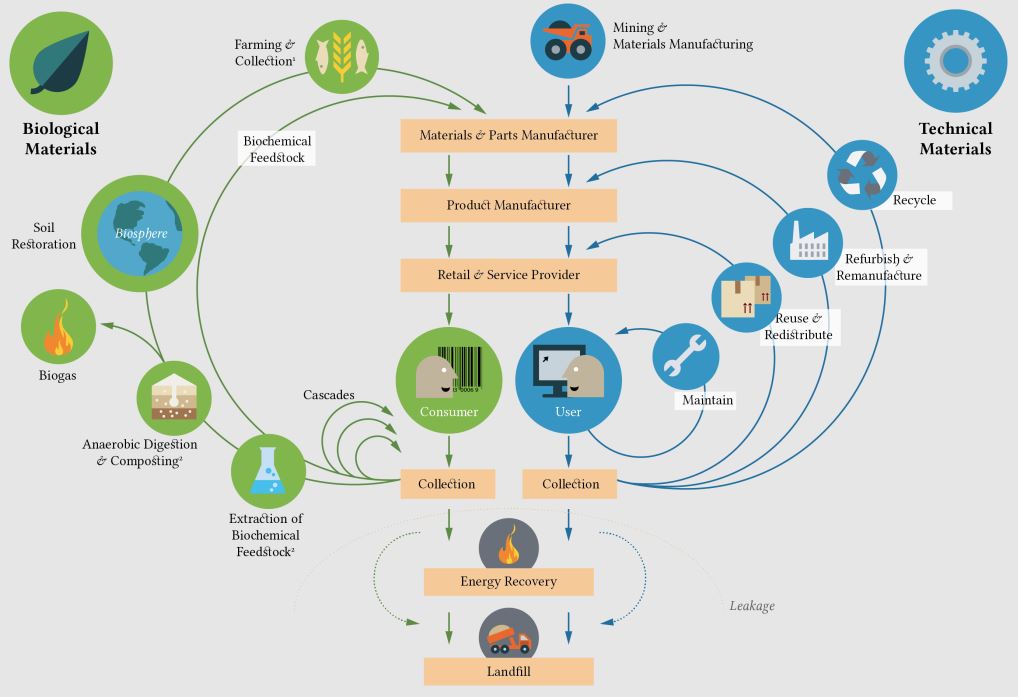2 Feature Analysis: Off-site Transfers to Disposal in North America, 2014–2018
2.5 Sustainable Production and Alternatives to the Generation and Disposal of Industrial Waste
2.5.1 Sustainable production and the concept of circular economy
To better understand the need to address current consumption patterns one must recognize that the world’s population growth rate has accelerated, as has the demand for products and services to satisfy basic needs. The purchasing power of consumers, including the consumption of short-lived products by those who can afford them, has increased. These trends in consumption patterns put the planet’s ability to provide raw materials at stake, which results in environmental and social impacts that will eventually exceed the economic benefits that developments in the productive sector can bring, making it unsustainable. The “produce-use-dispose” model, known as a linear economy model (Figure 25), consists of a sequence of stages from the extraction, production, and consumption of resources to the disposal of waste.
Figure 25. Produce–Use–Dispose (or Linear Economy) Model

To address the problems resulting from a linear economy model, as well as other problems related to human development and the environment, world leaders have adopted a set of sustainable development goals (SDGs) to eradicate poverty, protect the planet, and ensure prosperity for all as part of a new sustainable development agenda (Agenda 2030). One SDG of relevance to this report is SDG 12, which relates to sustainable production and consumption and the prevention, reduction, and management of waste (UN 2015).
Figure 26. Sustainable Development Goal (SDG) 12: Sustainable Production and Consumption

12.5 By 2030, substantially reduce waste generation through prevention, reduction, recycling, and reuse.
12.6 Encourage companies, especially large and transnational companies, to adopt sustainable practices and to integrate sustainability information into their reporting cycle.
Source: UN 2021, “Goal 12: Ensure sustainable consumption and production patterns”, Sustainable Development Goals.
Several international instruments and agreements relating to hazardous waste management support these objectives (some of which have been mentioned in section 2.3.3), including:
- Strategic Approach to International Chemicals Management (SAICM)
- Stockholm Convention on Persistent Organic Pollutants (POPs)
- Basel Convention on the Control of Transboundary Movements of Hazardous Waste and its Disposal
- Paris Agreement (GHG)
- Rotterdam Convention on the Prior Informed Consent Procedure for Certain Hazardous Chemicals and Pesticides in International Trade
- Minamata Convention (mercury)
- Montreal Protocol on Ozone Depleting Substances
- La Paz Agreement between Mexico and the United States (border region).
The Global Environment Facility (GEF) supports the implementation of projects to strengthen institutional and management capacities. For its part, the CEC has addressed the issues relating to chemical substances of global interest through the Sound Management of Chemicals program and the development of North American Regional Action Plans (NARAPs) that have contributed to the environmentally sound management of substances such as DDT, dioxins and furans, mercury, and the monitoring of POPs. The CEC has also coordinated projects related to cross-border movements of waste in North America and the development of guides to strengthen waste management practices (e.g., spent lead-acid batteries) (CEC 2016).
The World Business Council on Sustainable Development (WBCSD) focuses on consumption as one of the driving forces for more sustainable production. Sustainable production and consumption must be inclusive and consider governments, corporations, and society in order to minimize society’s environmental footprint through rational production and the efficient use of natural resources, while reducing waste generation and strengthening the supply of products and services. Based on the United Nations Commission on Sustainable Development, the WBCSD defines sustainable production and consumption as:
“The use of goods and services that meet basic needs and provide a better quality of life, while minimizing the use of natural resources, toxic materials, and emissions of waste and pollutants throughout the life cycle, so as not to endanger the needs of future generations.”[76]
Sustainable production can be promoted through certified product labeling, which allows consumers to make informed decisions about their purchases; direct payments for the use of natural resources; and the trading of permits for the extraction and use of raw materials. These alternatives to the “produce-use-dispose” model adhere to the principles of the circular economy, which promotes a greater degree of sustainability based on consideration of the life cycle of the products or services produced.
A widely recognized model of circular economy is that promoted by the Ellen MacArthur Foundation (Figure 27), as an alternative to irrational production and consumption worldwide. This model focuses on reducing consumption and promoting the creation of value through the extension of the useful life of a product, as well as the use of the materials and components of the product at the end of its useful life.
Currently, governments are contemplating various strategies to move from a linear to a circular economy, such as implementing economic incentives that can complement regulatory instruments, for example:
- Appropriate pricing of resources through fiscal policies to reduce environmental damage and generate substantial domestic revenue; for example, removing fossil fuel subsidies would generate $2.9 trillion annually, and reduce global carbon emissions by more than 20% and premature deaths from air pollution by 55% (UNEP 2017). These revenues can be used to support investments in clean technologies, natural capital, and social infrastructure.
- Establish taxes that impose a greater burden on the use of resources and pollution and favor sustainable production, as well as reuse, repair, and recycling.
- Adopt pollution charges and fees and “polluter pays” approaches, which make pollution prevention and reduction central to decision-making. Pollution charges are based on the quantity of pollutants discharged into the environment, while user charges are levied, for example, to collect and/or dispose of waste, or treat polluted water and soil (UNEP 2017).
[76] Adapted from Our Common Future (Brundtland Report), World Commission on Environment and Development, UN.
